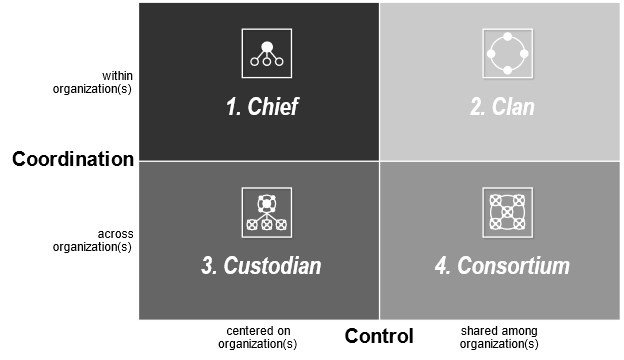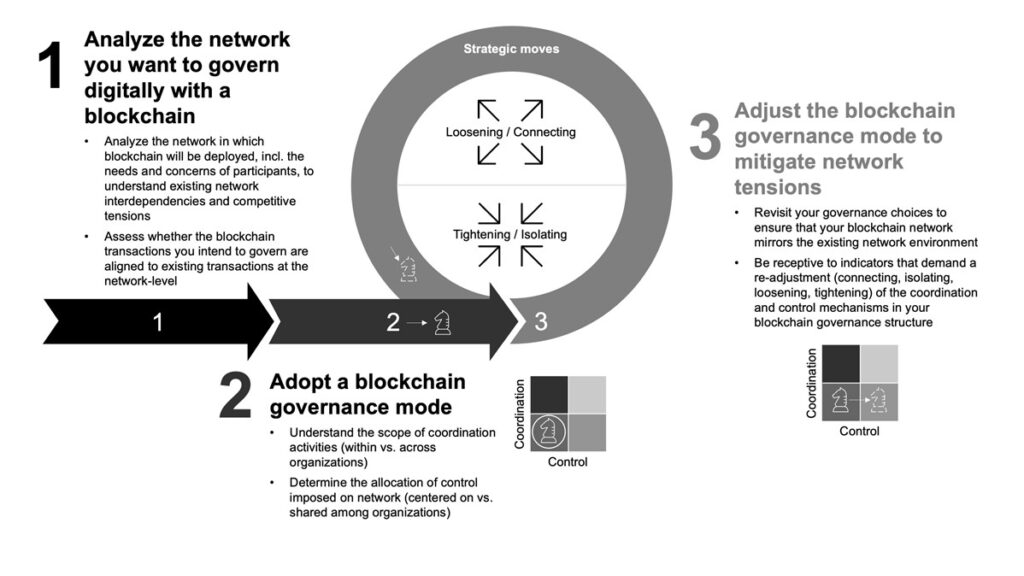The Boon and Bane of Blockchain
This post is based on an article, “The Boon and Bane of Blockchain: Getting the Governance Right,” by Curtis Goldsby, a managing consultant at IBM Corporation and a research scholar in the Technology and Operations Management department of Rotterdam School of Management, Erasmus University, and Marvin Hanisch, an assistant professor in the Innovation Management & Strategy department at the University of Groningen. Their paper was published in the Spring 2022 issue of the California Management Review.
The Idea in Brief
The Issue: Many enterprise blockchain initiatives fail not for technological reasons but because of poor management decisions in designing blockchain governance structures.
The Response: Managers can choose between four generic governance modes that we call (1) clan, (2) chief, (3) consortium, and (4) custodian. The choice depends on the coordination and control needs in blockchain network.
The Bottom Line: Successful blockchain managers have a thorough understanding of the network structures for which blockchains are used, choose the appropriate governance mode, and adapt it dynamically to changes in the network structure.
Four Modes of Governance for Enterprise Blockchains
Blockchain technologies are becoming increasingly popular tools for securing complex transactions involving many stakeholders. Despite the technology’s appeal and increasingly widespread adoption, there is little guidance for managers on how to design, implement, and adapt effective governance structures that enable the use of blockchains in an enterprise context. To address this need, we interviewed 153 blockchain managers and analyzed publicly documented use cases. What we found was that blockchain initiatives are most successful when the underlying coordination and control issues are clearly understood and accounted for at the onset. Based on our findings, we derive a corresponding framework that yields four generic blockchain governance modes: (1) chief, (2) clan, (3) custodian, and (4) consortium. Figure 1 provides a comprehensive view of the four governance modes for blockchains.

1. Chief
The chief mode emerges when a blockchain is orchestrated and directed by the same instance, i.e., coordination and control reside “in-house.” As such, it represents the most tightly organized and closed form of blockchain governance. For instance, the bank Wells Fargo adopted a chief mode for a blockchain network (“Wells Fargo Digital Cash”) that brought together internal departments and eased internal cross-border payments within the Wells Fargo Group. In general, the chief mode often occurs when large corporations fund and control blockchain initiatives designed to administer relationships with customers (e.g., loyalty programs) or subsidiaries (e.g., internal transfer pricing) while restricting the scope to the narrow confines of their own organization.

2. Clan
Similar to the chief mode, the clan mode coordinates activities within an organization but differs in that it permits shared control over the blockchain network. For example, the clan mode was adopted by Coca-Cola for 70 franchised bottling organizations operating across its $21 billion supply chain. Using blockchain in the Coca-Cola production line, bottling companies can fulfill orders for the brand more reliably and at a faster pace because inventory data is stored immutably and is transparently accessible. Generally, the clan is a blockchain governance mode that is often used when an organization and its subsidiaries, departments, or internal auditors strive to optimize operations and share control over information sharing, funding, decisions, and disputes among functional departments or national subsidiaries.
3. Custodian
The custodian mode applies when coordination occurs across organizational boundaries and control of the network is centered on a single actor. As an example, the custodian governance mode was successfully pursued by IBM’s Food Trust™ network for food provenance. This is a custodian governance mode because IBM coordinates blockchain-related activities with other network participants, such as farmers, truckers, and retailers, using a dedicated advisory council for industry alignment, operations, and mutual adjustments, but retains control over the blockchain’s governance in terms of funding and decision authority. Typically, a custodian mode is used when a large dominant organization in a network funds, designs, and implements a blockchain and leverages its existing network (e.g., suppliers and customers) to fuel growth. Contrary to the former two modes, coordination takes place across organizations, in that interorganizational relationships must be synchronized around a common blockchain purpose and operation.
4. Consortium
The consortium mode occurs when organizations come together to jointly control activities for a blockchain network across organizational boundaries. It thus represents the most open and collaborative governance approach. Take the luxury watch brand Breitling, for example, which decided to contribute to a blockchain consortium to benefit its customers. The consortium Breitling joined—powered by Arianee—holds the advantage that customers can enjoy the immutability and transparency features of blockchain for multiple luxury brands, such as the Richemont brands (e.g., Cartier, IWC). Because consortia are founded for cross-organizational blockchain networks and are essentially an association of several companies, we often see this type of governance mode when large corporations come together in a blockchain network to solve pressing business problems and activate global standards for an entire industry.
Bottom Line: The Blockchain Governance Journey
We integrate our governance typology above with a three-stage process model that summarizes the critical decisions involving blockchain governance: (1) analysis, (2) adoption, and (3) adjustment. We illustrate this process model in Figure 2 as a synthesis of the testimonies from dozens of managers who have gone through blockchain adaptation processes:
- Analysis: To identify the most appropriate blockchain governance form, managers need to carefully analyze the network in which blockchain will be deployed, taking into account the needs and concerns of participants, to understand existing network interdependencies and competitive tensions.
- Adoption: Managers should seek to understand for whom and for what purpose the blockchain is being used to tailor the coordination and control mechanisms to the network structure and the needs of the participants.
- Adjustment: Managers must be aware of governance dynamics in the network that may require continuous governance adjustments. Therefore, managers may need to adapt blockchain governance over time to allow for dynamic growth of the network. This process-oriented view of blockchain governance provides the flexibility needed to steer digital organizations.

Blockchain is fraught with hype. As organizations test blockchain technology and learn how to apply it to their specific organizational contexts, a game of natural selection will reveal which solutions prosper and which solutions fail. The governance of blockchains will be a critical factor in determining which companies benefit from the new technological opportunities. In our view, organizations that manage to move from siloed and competitive thinking to cross-organizational collaboration have the best chance of successful blockchain deployment with enduring growth.



























































































